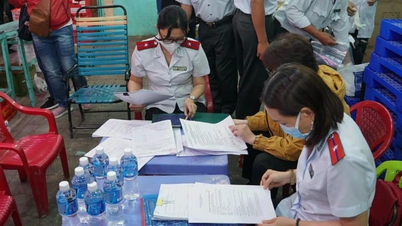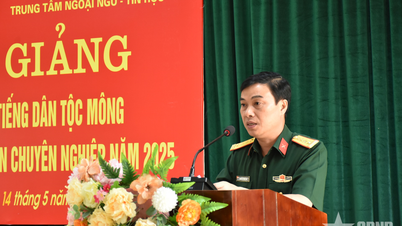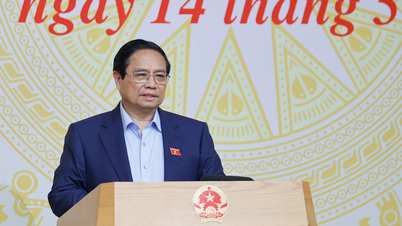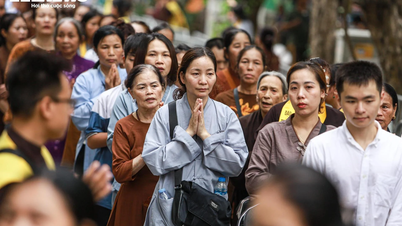For three consecutive years, the national fertility rate has fallen below the replacement level (2.1 children/woman), especially in 2023 at 1.96 children/woman and is forecast to drop to 1.91 children/woman in 2024, the lowest decline in history.
From low fertility to aging, Vietnam needs a comprehensive population strategy
For three consecutive years, the national fertility rate has fallen below the replacement level (2.1 children/woman), especially in 2023 at 1.96 children/woman and is forecast to drop to 1.91 children/woman in 2024, the lowest decline in history.
On December 27, the Department of Population (Ministry of Health) held a conference to review population work in 2024 and deploy plans for 2025. At the event, Director of the Department of Population Le Thanh Dung said that although Vietnam's population policy has achieved certain successes, this work is still facing many difficulties.
 |
Recently, some localities such as Ho Chi Minh City have implemented support policies to encourage people to have two children. |
For three consecutive years, the national fertility rate has fallen below the replacement level (2.1 children/woman), especially in 2023 at 1.96 children/woman and is forecast to drop to 1.91 children/woman in 2024, the lowest level in history. If this trend continues, Vietnam will face a natural population decline in the near future.
Another serious problem is the gender imbalance at birth, which, although decreasing, remains high, estimated at 112 boys/100 girls in 2024.
In addition, the aging population is also happening rapidly, as the proportion of elderly people is increasing and the health system is not capable of meeting the health care needs of this group. Improving the quality of the population, improving the physical, intellectual and spiritual health of the people still faces many challenges.
During the 2021-2025 period, Vietnam has set important population targets, including reducing sex imbalance at birth, maintaining replacement fertility and improving population quality.
However, to achieve these targets, a comprehensive strategy with strong participation of ministries and local authorities is needed.
One of the most important tasks is to focus on building and perfecting institutions, especially submitting to the National Assembly the draft Population Law at the 10th session (2025) to implement Resolution 21-NQ/TW on population.
In addition, it is necessary to implement population projects approved by the Prime Minister, especially programs on reproductive health care, family planning and improving population quality.
Communication work also needs to be strengthened to change people's awareness of population issues, especially the issue of low fertility.
Communication programs need to develop campaigns to educate the community about the importance of having two children and create a favorable environment for families to have and raise children in the best way.
In particular, recently, some localities such as Ho Chi Minh City have implemented support policies to encourage people to have two children.
Recently, the Ho Chi Minh City People's Council issued Resolution No. 40/2024/NQ-HDND, which stipulates reward policies for families that perform well in population work, such as supporting 3 million VND for women who give birth to two children before the age of 35 and 2 million VND for pregnant women and newborns from poor and near-poor households when performing prenatal and newborn screening.
However, these financial support policies are only incentives and cannot completely solve the problem of low fertility. Developed cities in the Asian region have used financial solutions to solve the problem of low fertility, but the results have not been as effective as expected.
Therefore, financial support must be accompanied by synchronous policies on education, health, housing and social security, to create the best living environment for young families.
Solving the problem of low birth rate is not a task of the health sector alone, but requires the cooperation of the entire political system and consensus of the community.
To create lasting effectiveness, a synchronous strategy is needed between policies on education, health, social security and economic development, especially policies to support people to have enough conditions to raise children in a stable and adequate environment.
In addition, to address the low birth rate, Ho Chi Minh City and other localities have adopted many new communication methods, such as using digital channels, social networks and mass media to raise public awareness of this issue. Effective communication campaigns will help the community better understand the current population situation and the necessary solutions to improve birth rates.
Nationwide, according to some experts, Vietnam needs to implement strong, comprehensive, and synchronous policies from the central to local levels.
The participation of ministries, local authorities and communities is very important. Population policy is not simply a matter of reproduction, but also a matter of sustainable development of the whole country. With the right solutions, Vietnam can completely improve the quality of its population and build a stable and sustainable development future.
Associate Professor, Dr. Nguyen Thi Lien Huong, Deputy Minister of Health, said that 2025 is the last year to implement the 5-year plan 2021-2025, the last year to implement phase 1 of the Vietnam Population Strategy to 2030.
To gradually find drastic solutions for 2025 and the following years to achieve the planning targets and tasks assigned by the Government, especially on new issues, turning point issues of Vietnam's population work in the spirit of Resolution No. 21-NQ/TW and Vietnam's population strategy to 2030.
Therefore, Associate Professor, Dr. Nguyen Thi Lien Huong requested the Department of Population to focus all resources on perfecting the institution, specifically completing the draft Population Law to submit to the National Assembly at the 10th session (2025) to bring Resolution 21-NQ/TW into practice.
Proactively develop 3 projects assigned in Resolution No. 68/NQ-CP dated May 9, 2024 of the Government and submit to competent authorities. Organize the assessment of the results of 5 years of implementing the Vietnam Population Strategy; review and summarize the population programs and projects approved by the Prime Minister to propose adjustments and implementation in the period 2026-2030.
At the same time, coordinate with relevant agencies/units in allocating resources for population work to ensure the implementation of 12 programs and projects on population approved by the Prime Minister and the Minister of Health. Coordinate with member ministries and branches to promote the activities of the National Steering Committee for Population and Development.
The Department of Population needs to urgently complete the draft guidelines for implementing population work in 2025 and send them to localities; focus on directing, guiding, and urging provinces/cities to mobilize resources and professional expertise on population to effectively implement population targets according to the plan set out in 2025 and the period 2021-2025.
Source: https://baodautu.vn/tu-muc-sinh-thap-den-gia-hoa-viet-nam-can-chien-luoc-toan-dien-ve-dan-so-d236090.html





![[Photo] Prime Minister Pham Minh Chinh chairs conference on anti-smuggling, trade fraud, and counterfeit goods](https://vphoto.vietnam.vn/thumb/1200x675/vietnam/resource/IMAGE/2025/5/14/6cd67667e99e4248b7d4f587fd21e37c)




























































































Comment (0)